Two Bigfoot Photographed Near Bradford, PA?
Posted by: Craig Woolheater on September 26th, 2013
From the Bradford Today forum:
OMG! Saturday, as part of the Kinzua Bridge festival they held a “Bigfoot calling contest”. I’m not really a believer of Bigfoot, and was busy Saturday, so I did not attend.
But my girlfriend and I did attend the Bridge festival on Sunday Afternoon. As we were headed back to Bradford in the late afternoon, I got a glimpse of what looked like two large, dark silhouettes in the forest.
I was able to stop the car and get the following amazing photos! They seemed to be heading in the direction of the Kinzua Bridge …. in the direction of the Bigfoot calls the day before!
The larger one seemed to be about 6 1/2- 7 feet tall and the second one was about 5 1/2- 6 feet tall.
We were not sure WHAT they were, but we were both certain they were NOT two bears walking on their rear legs!
Like I said before, before this sighting, I never believed in Bigfoot. I’m still not sure what we saw.
I’ll let these photos speak for themselves!
The photos were not altered in any way at all besides me shrinking them to fit on the page, and adding text to the very first one.
There was a “Bigfoot Calling Contest” at the Kinzua Bridge Festival on Saturday September 21st 2013 in the afternoon (3pm perhaps?).
On Sunday September 22nd, my girlfriend and I were leaving the Kinzua Bridge State Park at approximately 4:30 PM.
We were driving north (not sure of the road name) on the road that passes the park. About 4 or 5 miles north, I spotted out of the corner of my eye, something dark in the woods that looked like the shape of a “bigfoot or yeti”.
Then I stopped the car in the road. I then determined there were two “creatures”. One larger and one a bit smaller. I took photos out of the window, and slowly advanced the car forward for a better view through the trees and some brush along the road.
At first they seemed to be moving toward us, and then they appeared to turn and head away at a slow pace.
There were two distinct creatures and the space between them varied at times, but one appeared to follow the other.
We were on a narrow road and there was no shoulder or the shoulder was wet and soft, and we could not pull off. Soon there was too much brush and trees between us and the “creatures”.
There were more cars trying to pass us, so we finally drove off and headed home.
I am not one who would believe in Bigfoot or Yeti’s. I only believe what I see or can prove. I am not sure to this day what I saw there in the woods. They were very dark. I would say black. And it appeared it was long hair. I’m sure they were not black bears walking on their hind legs. They never seemed wobbly or unstable.
This is all the info I can offer.Stony
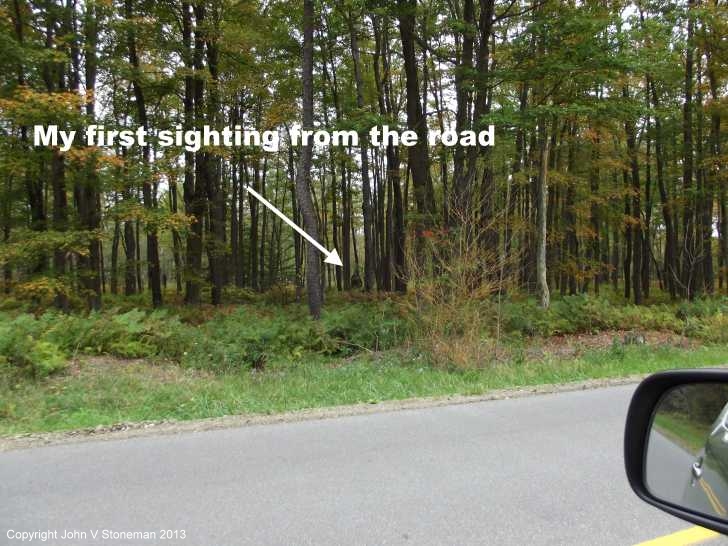
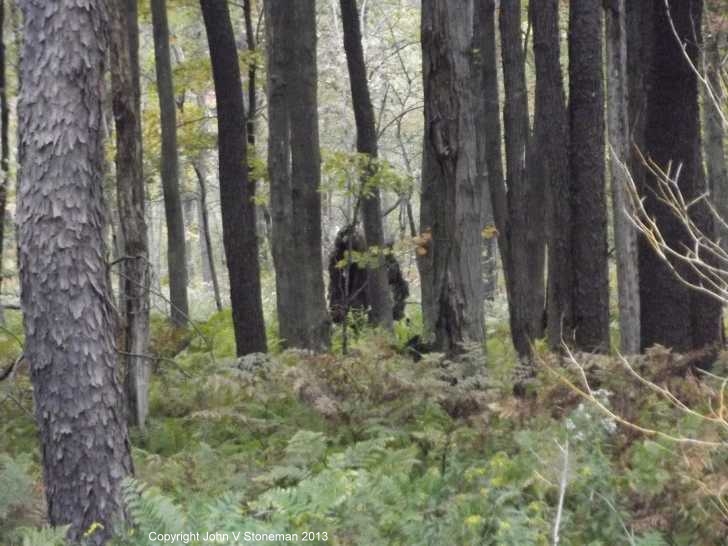
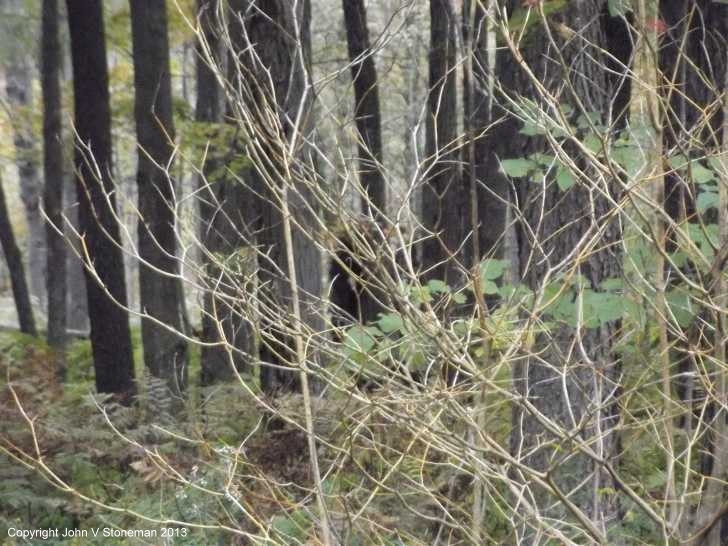

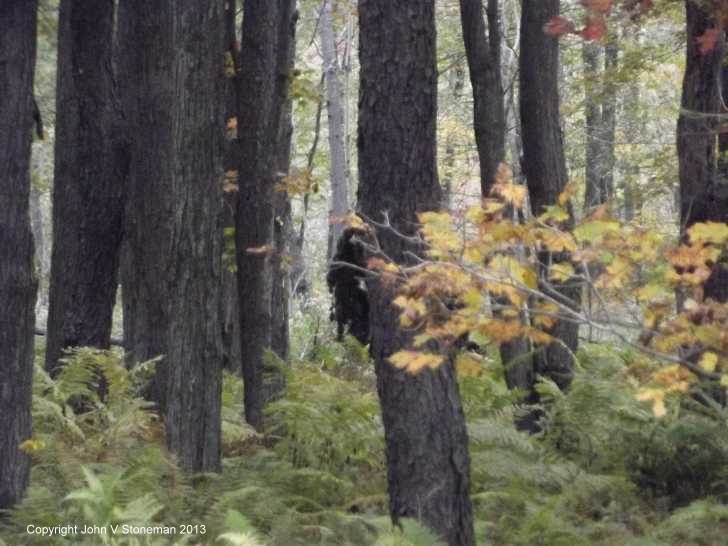



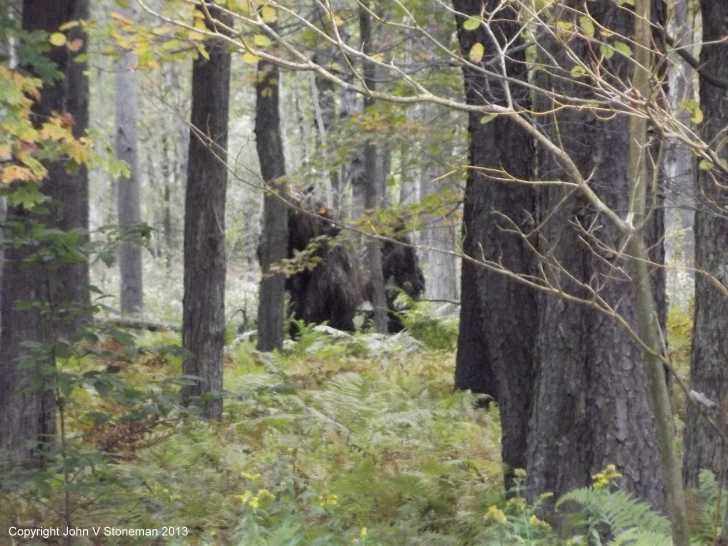
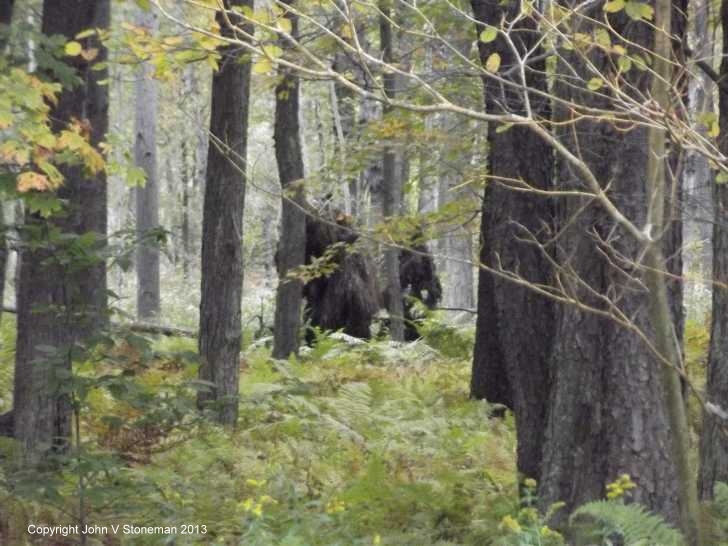
About Craig Woolheater
Co-founder of Cryptomundo in 2005.
I have appeared in or contributed to the following TV programs, documentaries and films:
OLN's Mysterious Encounters: "Caddo Critter", Southern Fried Bigfoot, Travel Channel's Weird Travels: "Bigfoot", History Channel's MonsterQuest: "Swamp Stalker", The Wild Man of the Navidad, Destination America's Monsters and Mysteries in America: Texas Terror - Lake Worth Monster, Animal Planet's Finding Bigfoot: Return to Boggy Creek and Beast of the Bayou.









i dunno….
interesting photos
but bigfoots near a festival?
seems to go against what you’d expect from an animal that wants to remain hidden…
The last two pictures appear to be black bears to me. I may be letting my eyes play tricks on me, but I think I can see a muzzle on the front most figure. I also think the bulk of the figure at the top doesn’t suggest an anthropoid. As for the other pictures, none of them are clear enough to make any kind of determination.
Ok…I know I’m letting myself in for it but, my first thought is that this is the over-turned root stump of a fallen tree. There doesn’t seem to be any of the movement that is described in the text as from image to image only the camera moves as the object stays exactly the same. Load the images in a preview program and rock #yeti4 and #yeti5 back and forth to see what I mean. The shape hanging down on the right in #yeti2 is far too long for an arm even for a Bigfoot but could be a thick twisted root with soil and other stuff. The last image seems to have the camera moving far enough to start showing the root stump coming into profile and then no more images. The up-turned roots of a large fallen tree can be 10 feet high…I’ve seen them easily that big after a storm. Interesting images but, I’m going with an up-turned root system from a fallen tree…the two Bigfoot creatures story not withstanding.
Ghillie suits
Cool photos – but, they look like ghillie suits to me. The “hair” is just hanging like that… Doesn’t look right. So, I have to say ghillie suits… Hunting season is starting.
Nightfighter Ghillie Suit
Waiting…
A festival with a bigfoot calling contest… and then a sighting. Methinks someone got pranked.
Those are Ghillie suits.
Looks exactly like guys in ghillie suits to me.
So should we assume they won?
No figure movement in the image series. Was the ghillie suit wearer posing? Obviously not hunting anything that close to the road. Again, it was within speaking distance and the photographer couldn’t tell what it was? The only delineation of two figures occurs in the story line provided by the photographer, there isn’t any in the images. I believe that these are a series of images of an up-turned tree root taken at slightly different positions and being partially obscured by closer trees. Rocking #yeti4 and #yeti5 images back and forth in a preview program will explain why I believe this to be the case.
I was thinking ghillie suit, then I saw Solomon Jacob’s pic of one, looks like a dead ringer. Gosh I moan at these pics.
Once again: no body, no major parts of a body, no live specimen, or no fossil, no proof.
Drowning in useless pics. Waiting for real evidence…
To my eyes at least Craig this just looks like shots of the same tree stump taken while performing a 180 0r 270 degree arc round the scaley tree and the short threadbare spindly bush near the edge of the road.
Hair is too long for a bear, Ghillie suits.
Ghille suits! Always with the ghille suits with you guys! There’s no one can tell you nothing!
Why not listen to your old friend cryptokellie for once? The man knows what’s what. You don’t know ghille from tuckus. That’s a pair of root balls I tell you.
Anyway what? You want that a meshugeneh what talks like a valley girl, with the OMGs and the exclamation this and exclamation that, should tell you there’s something in these pictures? Feh, don’t be a schmuck, save it for April fools why don’t you?
Bradford, PA? OK, then I must say that these are guys in ghillie suits prepping for archery season
Let me see if I can help put this to rest.
To do that, I need to increase the pixelation of the originals. Basically, I increased the pixelation 10X the original at 72 dpi to 712 dpi. That should give me a little bit of clarity to better see what we have going on here. Fortunately, the contrast and coloration is pretty good, better than most photos submitted here.
I can now tell you that we are definitely not looking at bears. I see what chadgatlin means when he posted the figures look like black bears at first glance but they are definitely NOT black bears.
A very good poster whom I like is Cryptokellie. So let’s take a look and see if they are upturned tree roots. I agree with Cryptokellie in that I have seen many Sasquatch photos presented here that resemble Sasquatch and turn out to be tree roots coupled with a case of pareidolia. Nope, they are not upturned tree roots and the shapes change dramatically at the bottom of the photos which indicate movement or a mobile living being. So the subjects in question are NOT trees.
The process of deduction is working nicely and we should soon deduce what the subjects really are. Ricardo Rodriguez is “waiting” and I don’t want to keep him or anyone else waiting any longer.
I compared the last two photos together after lining them up on top of one another. Those two photos were labeled “yeti9” and “yeti10” by the original photographer that submitted the photos. He took them in rapid succession. What I discovered, just below the tree branch that runs across the back of the subject, is a highly reflective area. Now almost all things reflect light. Grass is about 18% reflective and a mirror can be 99.9% reflective. But almost everything except pure dark rich black has some reflectivity of light. And we can assume several things based on that reflectivity. Highly polished plastics or manmade metals certainly reflect more light than fur or hair when viewed at just the right angle.
Even black fur has some reflectiivity because of oils and the structure of the fur. But one can differentiate between the reflectivity of fur and the reflectivity one would see from a manmade object, given the right angle.
Photos yeti9 and yeti 10 give us that precise angle. What we have on the back of one of the subjects, where the upper right part of the back would be, is a pretty large area of reflectivity of light. We would only see that type of reflectivity from a man made object that is highly polished such as metal or polished plastic. And interestingly enough, it only occurs in that one spot and is not bilateral. It only shows up in that one spot. If it were part of the fur, we would expect to see that same refective property taking place bilaterally and not unilaterally. In other words, if it were natural, we would expect to see that reflection spot on both sides or shoulders of the subject. That does not occur!
Through the process of deduction given the data presented, I can tell you with certainty that there is a highly reflective manmade object strung over the back of the subject, near the right shoulder.
Does Sasquatch carry around manmade precision tools of high reflectivity? I don’t know but I do doubt the veracity of such a statement. That would indicate to me to think of a scenario that is more probable than not. And since hunting season is at hand and many hunters, although maybe not even hunting but scoping out just the right place for a tree stand, are in the woods near populated areas. Were these photos taken near a populated area? Yes, a festival recently occurred there and we can see part of the road in the first photo. Why would hunters be wearing ghillie suits? Well, if they are actually hunting, they would wear them to disguise themselves from their prey. If they are scouting an area they would eventually hunt, they want to see what trophies may exist in that area. So are they most likely ghillie suits and NOT Sasquatch?
Definitively YES! I would agree with the majority of posters based on simple observation and common sense, backed up by photo analysis and the process of deduction. These subjects are two men in ghillie suits!
End of story!
P.S.: I usually post the results of my photo analysis here at Cryptomundo in the way of photos. I will do that if the subject matter is highly questionable or hard to decipher. I also do photo analysis on photos that bring up a large number of members debating what the subject could be. I don’t mind posting a photo or two. But in this case, it was already self evident to most posters that these were men in ghillie suits and there were quite a few photos. To post them all for such a trivial analysis is an unproductive waste of my time and Craig’s time. In this case, there are just too many photos to post for such a simple answer. You will just have to take my word for it this time or do your own photo analysis by comparing the last two photos by lining them upon one another and toggling back and forth. You will see the man made reflective spot that does not occur naturally!
@ Photoexpert,
Allow me to play devils advocate with your findings, with the preliminary statement that admittedly either of us may be right or we both may be wrong.
I say over-turned trees, or root balls.
This often happens where trees grow on rocky ground. There is no true soil, only a thin distinct layer of humus over rocks. The tree roots are shallow and the trees tip over easily, exposing large flat disc shaped clumps of roots, humus and stones.
Pictured is a classic example of this with dangling roots, very dark humus, and very light stones. Many stones of various sizes can be seen, and they are very light compared to the dark humus. It is also possible that some of the light areas are the background lanscape exposed through holes in the root clumps where the humus and stones have fallen away.
Your metallic object appears to be a stone on a portion of the root ball where the sunlight is striking the rootball with slightly more intensity than the rocks shown in the shadow of the root clump.
While I always enjoy your evaluations, a 72 pixel per inch picture is not going to reveal any more reliable information when converted up to a higher resolution. You are only trading squarish pixelation with soft fuzziness. This is only good for rorshaching. While the mind can puzzle out many things by doing this, we must be careful not to present the results as anything more than supposition. You are selling your suppositions as proof bona fide.
As far as reflections, here is where upsampling of pixels works against you. The pixels as given must be accepted as the best evidence to go by, crap as they are. Reflections will cause some degree of refraction in the lens which is picked up by the color chips in the camera. Examining the pixels at a magnified view (different from up sampling resolution) will show a rainbow speckle in the noise of the pixels, especially at edges of the object. That spot in question has a noise color consistent with other identifiable natural objects of relative lightness. Admittedly this is flawed as we do not have the original photos to examine, but it is all we can do with what we have, and is less flawed than upsampling before examining.
Concering the area that I call a stone and you call a reflective object, allow your eye to travel straight down from there to the ground. You will see stones or perhaps a lichen covered log that is actually lighter than the “reflection”. A reflective object should throw more light into the camera than a rough textured object of similar color.
I would like to hear more about the changing shape of the bottoms of the subjects. I have not studied them other than by eyeball and am not seeing what you are referring to. I am open to persuasion if you can show me there are changes other than those of camera movement and flora movement from wind. I am an open mind in the matter and you may yet convince me my root clumps are ghille suits.
Cheers.
Great analyses…at least we’re not seeing Bigfoot in these images. I live in PA. but Bradford is 5 + hours Northwest from me otherwise, I’d take a ride and look a little. I think I’d find an up-rooted tree there…lol.
I need the Cliff Notes to PhotoExpert’s post 🙂
I agree, though, and with the others, very Ghillious.
@ cryptokellie,
I’m not too far from Bradford. Bradford and Sullivan are two of the prettiest counties in the state, with forested mountain ridges that just fall away to breath taking vistas. Notice in the first pic how far down on the tree line the sky shows, it probably drops right off a few hundred yards back.
I hear Bradford is getting the hell fracked out of it even worse than where I am which is plenty bad enough. I hate to think what beauty is now permanently scarred out that way. What little money they make out there I’m guessing they can kiss the tourist dollars goodbye…
In order to avoid work, I’ll type one more comment that is strictly a historical look of the Bradford county area that these supposed bigfoots are inhabiting.
This whole area was once virgin forest. For those of you who don’t know what that means, imagine 5 men touching fingertips while hugging a tree and not meeting on the far side (there are still some virgin beech in the state forests in nearby Lycoming county to the south). A solid block of it much bigger than this county alone. The white pine was logged down to nothing in the 1800s. Once round wire nails were invented, the hemlock, which split with square forged nails, became valuable and were logged down to nothing in a second wave of deforestation in the late 1800s.
The logging set up conditions that allowed a historic wild fire to burn this entire corner of the state, crippling the ability of the inhabitants to live off the land for a generation or so. The blueberries that sprang up immediately after the fire are still well established all through this area, despite the regrowth of tree cover.
In this area you farmed, logged, worked at the tanneries that sprang up from the surplus of bark, or worked the rafts to float the logs to Lycoming county. The area is remote enough that rule of law was mostly non-existent, and made up on the spot by whatever number of people were gathered. A jury of your peers was literally the 4 or 5 guys in camp when the corn dodger was stolen. Punishment for most every offense was impromptu hanging and leaving the hanged on display. There are reminants of this attitude that survive to this day, minus the lynching of course.
Land owners here were sometimes displaced by an ongoing dispute between Pennsylvania and Connecticut who both claimed the land.
While we like to think of ourselves as the top of the food chain, residents of this area were routinely devoured by wolves, killed by mountain lions, kidnapped by both real native american “indians” and mormons migrating west who were also called “indians” or “gyspy indians”.
While we think of wolves and mountain lions as ancient history, being killed and devoured by wolves while traveling in this area was still common at the end of the last century. Some of your grandparents are old enough to have been a meal to a predator.
Mountain lions were gone for the longest time, but have returned, and local residents think there is a conspiracy by the government to not only deny their existence, but also re-introduce them to the mountains.
Superstitions here included witches, ghosts, indian ghosts (there was a distinction), an odd beastiary common to most of the appalachians of thought-to-be-real, and known-to-be-tongue-in-cheek animals, but not much in the way of bigfoot lore, like you have in new england and northern new york.
Could bigfoot live here? Meh, maybe, or more likely they could use it as a migrational route. But then there is always the whistling wildboy of Binghamton, NY, which, while a hike from these parts, is still a city that was once connected by the same massive forest…
Finally, finally I was able to get past the Word Press system and post!
hoodoorocket–Hello, my friend! I hope you did not give up on me and checked back in. I left a message for you in the Jane Goodall thread, hoping you would read it.
Anyway, hoodoorocket, I am glad you are playing Devil’s advocate. That is a good thing, not a bad thing. Plus, who else is going to keep me on my toes?
hoodoorocket, you know, at first glance, initially I thought they were root balls too. I am very familiar with these types of formations since I find myself in the woods and tropical jungles from time to time. It looked just like them to me, until a got a few photos into viewing them and noticed the odd shape. Not that root balls do not have odd shapes now and then, but it captivated me enough to further analyze what I was viewing.
The metallic object which you call a stone, I refer to as a polished manmade object. Yes, it could be metallic but I thought I made it clear that it could be any manmade polished object. So I don’t want to be pigeonholed there by your terming it a metallic object. Even if you are playing devil’s advocate, I have to reiterate my stance so that it is not twisted into something it was not. So yes, I understand where you could state that the polished manmade object is a stone. So far, we are both in agreement, if you remove the metallic object reference. Up to this point, you are an angel’s advocate since we both agree.
I am glad you always enjoy my evaluations! Thank you for that! Now let’s see if we are still in agreement. Yep, you are correct that when we increase the pixelation there is a trade off. But not all the time! Just sometimes! Sometimes it does help to increase the pixelation and sometimes it does not and we end up with what you refer to as “rorshaching”. I call it pareidolia. But we would just be arguing semantics. Call it rorshaching or paeidolia, it is basically the same thing. Guess what? I agree with you there too! In fact, I have written about this before here at Cryptomundo in the Bigfoot Massacre thread. Yes, when you increase pixelation, you add artifacts because pixels are not there that were there before. It changes the original. So we are both in agreement there. But I always keep an original and also do a copy adding pixelation. It sometimes helps in a few cases. An example would be the Canadian Lynx post here where I was able to determine that the subject in the photograph was not what it appeared to be. Added pixelation actually helped in that case. For the most part, I agree with your statement. In this case, increase the pixelation was not that beneficial for photo analysis. So for the sake of argument, barring one disclaimer to your advocating statement, we are still in agreement. Wow, at this point you are still an angel’s advocate.
Let’s move on shall we, since we are both in agreement to this point. On to reflections. The upsampling of the photo does not work against me here as you state. It just does not lend any benefit or further enhance credibility to my analysis on it’s own. The key words are: “on it’s own”. When doing analysis, many times it is necessary to combine one finding with another. But it certainly does not work against me as you state. Here is where we begin to part ways a bit. I am not in disagreement with you yet, but here is where a photographic expert would begin to look for other indicators. You’re still an angel’s advocate to this point. You stated: “Admittedly this is flawed as we do not have the original photos to examine, but it is all we can do with what we have, and is less flawed than upsampling before examining.” So you also see what I am up against and still in agreement with me as I am with you, the original is what it is and not great.
Here is where I begin to disagree with your Devil’s advocate position slightly. You state: “A reflective object should throw more light into the camera than a rough textured object of similar color.” The key word in your statement is “should”. It should but does not always turn out to be that way. The angle of the reflective object from the light source to the camera lens, does in fact increase or decrease the amount of reflectivity. Also the shape of the object where the light is being reflected from also contributes to it’s intensity. And this is where we part ways and I disagree with you. In other words, a highly reflective object can reflect less light than a stone. It happens all the time. It is basic physics. So your argument loses all strength at that point in time for me. But still, even given your incorrect statement, you could be correct about your overall hypothesis. Even though we are in disagreement to this point, there is no evidence to prove your opinion incorrect.
Moving on then! Now we are at the point where I am in total disagreement with you. Here is where we will either part ways in disagreement or I can persuade you to my side. We’ll see if you are going to remain a Devil’s advocate or an Angel’s advocate.
You stated: “I would like to hear more about the changing shape of the bottoms of the subjects. I have not studied them other than by eyeball and am not seeing what you are referring to. I am open to persuasion if you can show me there are changes other than those of camera movement and flora movement from wind. I am an open mind in the matter and you may yet convince me my root clumps are ghille suits.”
My reply: If you compare the photos yeti5, yeti6, and yet7, one should look at the left side of the subject in question, namely what looks like an extended arm. And although the angle of the photographer may have changed slightly, what should not have changed at all, is the angle or bend in the arm. That has change. That change indicates movement. Which makes the object an animated object and not an immobile object such as a root ball. This where we disagree. You admitted to not looking at the photos sequentially for any length of time and are open to persuasion. Could wind have caused that movement as you suggest. Perhaps, what looks like an arm moving to me inside a ghillie suit, admittedly could be strong wind moving the moss at a weird angle. But we have to take into account that data of possible arm movement. There is animation to the subject in question at the extremities. So we have to see where ruling out wind, would remove all doubt that the subject is not a root ball and indeed animated.
To prove that, I would have to prove that wind has no bearing on the motion of the subject at all. With that being a given, I would submit to you the final two photos, labeled yeti9 and yeti10. These two photos were taken in rapid succession, milliseconds apart. The great news is that they were taken milliseconds apart and from the exact same point of view from the photographer. He never moved! The constant is the camera position, the sun’s position, the foliage’s position, etc. If the subject were indeed an animated object and not a root ball, the body of the subject would have to move. Forget about the extremities, because a very stiff wind could blow a portion of the root ball. Although that is very improbable, it is not impossible. What would be a near possibility, is the wind being able to move the entire weight or mass of the root ball without damaging any trees or foliage in the photo labeled yeti10. But I would have to establish movement of the massive body of the subject in question.
Don’t loose me now hoodoorocket! Try to keep up with my analysis here. I want to make you a believer in me and not a Devil’s advocate.
Remember when I stated those key words, “on it’s own”, pertaining to reflections. For the sake of argument, let’s say you were 100% correct about that. Let’s give you that even though it was not correct. So let’s say the it was a stone in the moss of a root ball. That stone, along with the body of the subject, moved forward as evidenced in comparing yeti9 with yeti10. How do I know this? Because the “stone” you see is barely showing a reflection in yeti9 and IS showing a strong reflection from the sun in yeti10. How could that be unless the stone imbedded in the body of the subject, moved forward? It would mean the entire mass of the root ball moved forward. Root balls do not do that! And we do see that both subjects in question have moved forward slightly, indicating movement of both subjects. We now know the photographer has not moved in those milliseconds. We also know the angle of the sun has not moved in those milliseconds or moved dramatically enough to create a harsh reflection from what you call a stone. The sun moves at a constant rate and can not jump around as would be suggested, if the object was inanimate.
Therefore, the only conclusion that can be made is that the subjects in the photograph are moving by self animation. It is not wind, the sun is not jumping around willy nilly, the photographer’s position has not changed in the last two photos. Yet your root ball or mass has moved as explained by physics and optical physics. Through deduction, these are either some unknown creature or most probably men in ghillie suits. What could differentiate them between being a BF and men in ghillie suits? Well, if the reflective object is not a stone, it must be a manmade object as I suggested. What other factors do we know. Are there ghillie suits produced like this? Yes! Is it near hunting season where men in ghillie suits might be searching for prey animals? Yes! Could it be hunting season or even illegal hunters while wearing ghillie suits are carrying a rifle or bow on their back? Yes! Would a bow made of resins or a gun made or resins, polished wood or highly reflective metal be carrried by the hunters? Yes, of course!
So take a look at the proof I have supplied for you. And since you have not done it yet, closely compare the last two photos and also the photos wear I stated they look like a bending arm and the angle of the bend changes. That can’t be moss moving by the wind since we have proven it is an animate object and the sun does rapidly change angles. Nor do root balls! Unless root balls move, these are two men in ghillie suits as proven by careful photo analysis.
Peersuasive enough for you, given physics, optical physics, the sun’s inability to move rapidly, etc? Are you going to remain a Devil’s advocate or calmly agree with the scientific data presented and move in the Angel’s advocate realm or reality?
Case closed! At least for me!
We’ll have to agree to disagree.
I don’t have the type of computer software to look at these as closely as needed here at work, and cannot overlay them on each other, so I can’t see where the arm movemnet is that you describe. I did look at both 9 and 10 at ms paints highest magnification of 800%.
First I see such extreme jpegging as to realize neither one of us can do anything but guess as these are a mess.
In 9 and 10 I see no change in shape that leads me to believe the subject has moved. I do see an artifact that says the light colored object is present in both pics in the same spot. The jpegging is so horrible that the object might have been exactly the same in both original shots, just rendered differently during the two compressions.
While a majority of the leaves in the foreground are alomst the same, there are some minute differences. There is a branch of leaves that goes right by the light object and the horribly jpegged leaves on that branch blob up slightly different in shape and color between 9 and 10. For example if you allow your eye to drift up and slightly to the left from the light object you will see a group of leaves that are reflecting light moreso in 9 than 10. This indicates a slight breeze is seesawing all the leaves along its course. If I were to change my opinion it might be that the light object actually is a leaf reflecting light, but doesn’t convince me this is a guy in a ghille suit that has moved.
I still put my money on “stone”, but it is irrelevant because this roulette wheel isn’t spinning.
I can’t believe there were only 2 people in bigfoot costumes spotted after a festival…
@hoodoorocket
I don’t see anything that suggests movement either; I do see that 9 and 10 are not the same. There is a tilt.
These slight movements (and angle changes) of the camera are enough to cause these illusions. Especially when branches, foliage and root balls are involved.
@PhotoExpert
“the scientific data presented”
Getting it all wrong and then adding “Case closed!” on top of it.
A wonderful scientific methodology you’ve got going there.
Guys in ghillie suits , no doubt about it. I have one . No need to be excited over this .
Bigfoot HOAX In Pennsylvania? Tipster Says ‘Two Bigfoots’ Were Tree Stump
It was a hoax and Stoneman knew this was a root ball according to the Pennsylvania Game Commission. They were on location when the above photos were taken by a gas well worker on Sept 27. Stoneman or someone else with interest in it tried to hide the root ball by flopping it back in the hole by Sept 29 but it was too late these pictures were already taken. The Pennsylvania Game Commission commented to the Pennsylvania Bigfoot Society that this is indeed the root ball that was supposed to be a Bigfoot in Stoneman’s photo.
My Thanks to Cryptomundo for fixing my post.